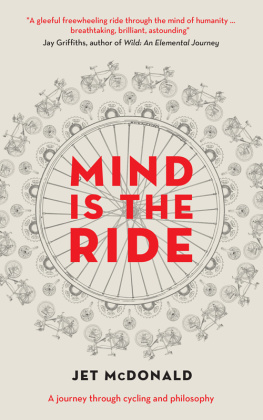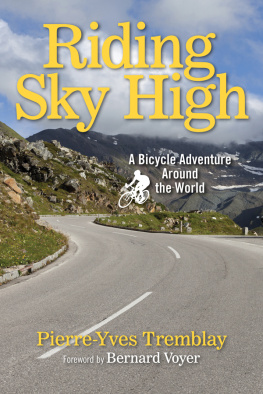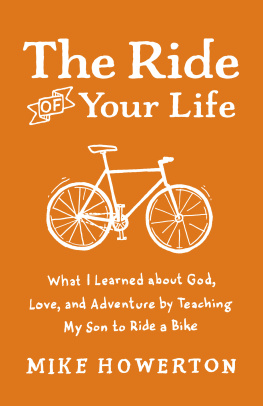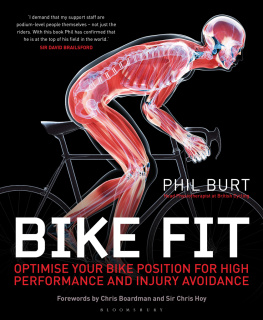
For Jen and Sol
Contents

CHAPTER 1
The Virtual Triangle
The arrow west read BRISTOL MILES , the arrow east IN DIA 4300 MILES . We straddled the bikes, rang our BELLS and slowly, very slowly, pedalled east.
It was time to put on my cycling glasses. Id ordered them especially off the net, thinking they were what a serious cyclist would need, but hadnt expected super-chunky lumps of plastic that made me look like Elton John in his seventies glam rock phase. I shot Jen my Dont say anything about my glasses look and moved into second gear. Five miles later we stopped for breakfast.
The Bristol and Bath bike path is built on the remains of the Midland Railway, dotted here and there with old platforms. Five miles from the centre of Bristol there is a cafe squeezed into an abandoned ticket room, where dawdling cyclists can get a cup of tea and a chip butty.
Jen having no kick stand leaned her machine against the wall. I propped mine on its metal legs so that I could fully admire its new paint job and ridiculous freight of luggage. There were two pannier bags on the back, two hanging on the front and one BA R BAG on the HANDLEBARS . Because of all this the WHE ELS were obscured, leaving only the central part of the frame in view, a kind of stubby triangle. The spring sunshine projected the shadow of this triangle onto the grass beyond. Commuters cycled past paying no attention.
Does no one care! I let my tea cup fall into its saucer and peered at Jen through my rocket-powered glasses. They were light-sensitive and had turned a shade of puce yellow.
Live and let live, she said.
I pulled my glasses down my nose so I could look more directly at their seemingly tawdry lives.
After three years of planning, saving, negotiating and ramming stuff into pannier bags it felt as if the excitement was brimming out of my head, and the fact that no one seemed to notice was bizarre, if not a little rude. None of this was lessened by sleep deprivation, which gave the scene an unreal flatness. My attention drifted to the shadow of the bike created by the frame and the early-morning sun. It had a pleasing simplicity. A triangular map. From Bristol to Istanbul to Mumbai and back again.
One of the most famous allegories of ancient philosophy is Platos Cave. The story goes that a group of prisoners are held in chains at the back of a cave facing the wall. Behind them a series of puppets are danced in front of the flames of a fire, casting shadows on the wall that the prisoners are facing. The prisoners believe these shadows to be the nature of reality. This is analogous to our everyday perceptions, which are not the true nature of things, but merely a function of our sensory organs. Only if a prisoner is dragged to the mouth of the cave would he see the sun, which represents the universal truth, the unchanging ideal that underpins our fleeting perceptions.
A bike shadow is a cyclists best friend. Its an X-ray of the riders imagination. Its never-changing geometry follows just behind or ahead, on an icy road, a desert plain, a dual carriageway. And at the peaks of hunger and the depths of exhaustion, it begins to talk with you. It begins to turn you inside out. What is your purpose? What is meaning of the rumbling road? What is the unchanging truth at the centre of the central reservation? Why didnt you remove the WHEELS , PEDALS and HANDLEBARS , put the whole shebang in a suitcase, and take the train?
I called my touring bike Bertle, given that it resembled a beetle and had a dependable Bertness, while at the same time retaining a female yoni or elle in its saddle-shaped curves (Jen meanwhile called her bike Billy). It was only after the trip that I realised the bike was also called Bertle after Bertrand Russell, a pipe-smoking radical atheist with a profile curiously like that of a beetle. Russell is the author of the handbook The Problems of Philosophy . At 165 pages and half the size of a sandwich it can easily be slipped into a pannier bag, and as I dipped into it during those first few days, I began to hear a shadow voice, Russells voice, like a kind of metaphysical satnav. I imagined him tapping the frame of the bike with his pipe as he navigated a scholarly path through reality.
When we perceive a bike, he explained, we perceive the particular sensory information of a bike colour, texture, etc. but what gives the bike its bikeness is a universal understanding of these elements and how they relate to each other. The upshot of this is that while two observers may not agree that my bike has the same particular qualities of colour or texture, both might agree that all those parts together have a quality of bike that is universal. That it is, in other words, a bike.
Iain McGilchrist, psychiatrist, literary don and one-time neuroscientist, is the author of The Master and His Emissary , a popular and controversial study of the differing roles of the right and left hemispheres in the brain. In the book he shows a drawing of a bicycle made by a patient with a right-hemisphere deficit, where the WHEELS have been pictured above the larger PEDALS ; all the parts of the bike are included but their relationship to each other, in space and proportion, what we might call its bikeness, has been lost. The right hemispheres tendency towards integration influences our ability to understand metaphor, to bring older meanings together into a new whole, whereas the left inclines towards a representation of things as they are, stripped of context.
A friend who bought a BMX bike but decided that he didnt like the frame took the components off that frame and added them to another. Later that frame broke and he replaced it and kept the original components. But for him the bike still retained the quality of being the original bike hed had all long. Hed always assumed it was the frame that gave it its identity but here it was several editions later retaining its bikeness.
The bike itself, in the form we know it, has only been around for 150 years. But there is something so right about the way that a bike connects to a human being that there must be a timeless notion of what it means. Bikeness may have less to do with the object itself than with how we connect to it. The first roll down a hill on a bicycle, balance intact, is the joyous swallow dive of youth. Before the bike existed we had no learning-to-ride feet-off-the-ground epiphany, because there was no pedal to push, and yet that moment seems familiar, ageless and universal now because it is a part of being human. Our bodies long ago evolved to ride a bike, its just the mind had to catch up to invent it.
Two best-selling books about cycling have been Its Not About the Bike , the story of racing cyclist Lance Armstrong (before his fall from grace), and Its All About the Bike , the story of Rob Penn, who went around the world searching for the ultimate components with which to build his dream bike. Lance Armstrongs title suggests that the value of cycling is unrelated to the bicycle, rather to the motivations that surround it, while Rob Penns, tongue in cheek, suggests the opposite. In fact, its neither not about the bike nor all about the bike. Its all about the apostrophe, the indefinable something that connects the it to the is, that joins the fleeting particular to the immutable universal.
Now a teacher of English might reasonably argue that the apostrophe represents a lapsed i, but the eccentric rider through the imagination would argue that the apostrophe is in fact the travelling I, the self on a trip between the mutable it and the immutable is, adrift from the workaday typeface on its daily commute from left to right.
Next page








